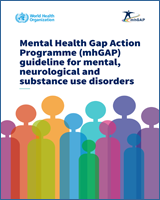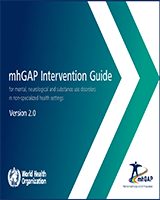- »
Multiple persistent physical symptoms with no clear cause - »
Low energy, fatigue, sleep problems - »
Persistent sadness or depressed mood, anxiety - »
Loss of interest or pleasure in activities that are normally pleasurable
| DEPRESSION (DEP) |
- »
Marked behavioural changes; neglecting usual responsibilities related to work, school, domestic or social activities - »
Agitated, aggressive behavior, decreased or increased activity - »
Fixed false beliefs not shared by others in the person's culture - »
Hearing voices or seeing things that are not there - »
Lack of realization that one is having mental health problems
| PSYCHOSES (PSY) |
- »
Convulsive movement or fits/seizures - »
During the convulsion: loss of consciousness or impaired consciousness, stiffness, rigidity, tongue bite, injury, incontinence of urine or faeces - »
After the convulsion: fatigue, drowsiness, sleepiness, confusion, abnormal behaviour, headache, muscle aches, or weakness on one side of the body
| EPILEPSY (EPI) |
Child/adolescent being seen for physical complaints or a general health assessment who has:
- »
Problem with development, emotions or behaviour (e.g. inattention, over-activity, or repeated defiant, disobedient and aggressive behaviour) - »
Risk factors such as malnutrition, abuse and/or neglect, frequent illness, chronic diseases (e.g. HIV/AIDS or history of difficult birth)
Carer with concerns about the child/adolescent's:
- »
Difficulty keeping up with peers or carrying out daily activities considered normal for age - »
Behaviour (e.g. too active, aggressive, having frequent and/or severe tantrums, wanting to be alone too much, refusing to do regular activities or go to school)
Teacher with concerns about a child/adolescent
- »
e.g. easily distracted, disruptive in class, often getting into trouble, difficulty completing school work
Community health or social services worker with concerns about a child/adolescent
- »
e.g. rule- or law-breaking behaviour, physical aggression at home or in the community
| CHILD & ADOLESCENT MENTAL & BEHAVIOURAL DISORDERS (CMH)
Common presentations of emotional, behavioral and developmental disorders vary by age in children and adolescents. |
- »
Decline or problems with memory (severe forgetfulness) and orientation (awareness of time, place and person) - »
Mood or behavioural problems such as apathy (appearing uninterested) or irritability - »
Loss of emotional control (easily upset, irritable or tearful) - »
Difficulties in carrying out usual work, domestic or social activities
| DEMENTIA (DEM) |
- »
Appearing affected by alcohol or other substance (e.g. smell of alcohol, slurred speech, sedated, erratic behaviour) - »
Signs and symptoms of acute behavioural effects, withdrawal features or effects of prolonged use - »
Deterioration of social functioning (i.e. difficulties at work or home, unkempt appearance) - »
Signs of chronic liver disease (abnormal liver enzymes), jaundiced (yellow) skin and eyes, palpable and tender liver edge (in early liver disease), ascites (distended abdomen is filled with fluid), spider naevi (spider-like blood vessels visible on the surface of the skin), and altered mental status (hepatic encephalopathy) - »
Problems with balance, walking, coordinated movements, and nystagmus - »
Incidental findings: macrocytic anaemia, low platelet count, elevated mean corpuscular volume (MCV) - »
Emergency presentation due to substance withdrawal, overdose, or intoxication. Person may appear sedated, overstimulated, agitated, anxious or confused - »
Persons with disorders due to substance use may not report any problems with substance use. Look for: - –
Recurrent requests for psychoactive medications including analgesics - –
Injuries - –
Infections associated with intravenous drug use (HIV/AIDS, Hepatitis C)
| DISORDERS DUE TO SUBSTANCE USE (SUB)
All persons presenting to health care facilities should be asked about their tobacco and alcohol use. |
- »
Extreme hopelessness and despair - »
Current thoughts, plan or act of self-harm/suicide, or history thereof - »
Any of the other priority conditions, chronic pain, or extreme emotional distress
| SELF-HARM/SUICIDE (SUI) |


